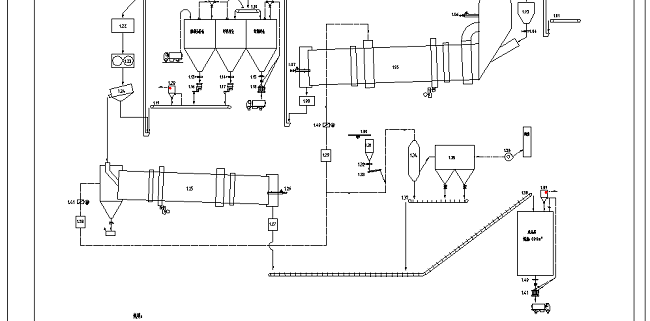In recent years, the ceramisite industry has actively responded to the basic national policy of resources and environmental protection, using construction waste soil, municipal sludge and sludge as the main raw materials to produce ceramisite, which has achieved good economic benefits and greatly relieved the enormous pressure brought by environmental factors. Ceramic is widely used as building materials, green materials, food and health materials, industrial filter materials and so on. A wide range of applications have attracted many people to enter the ceramsite preparation industry. Now, several conventional ceramsite preparation methods are briefly introduced. At the same time, the differences between sludge ceramsite preparation are analyzed.
I. Bauxite Ceramic Sand Technology
1. Crushing: The bauxite that is mined usually crushes the stone about 300-500 mm to the size less than 8 mm.
2. Ingredients: Bauxite, manganese powder, recycling and other materials are respectively transported to their respective warehouses, under which a speed-regulating belt scale is set up to realize automatic burden metering.
3. Grinding: Ball mill with both drying and grinding is generally used, and high-efficiency separator is matched to form closed-circuit system. The hot air for drying materials can come from the waste gas of rotary kiln to make use of the waste heat, and special hot air stoves can also be set up.
4. Ball making: raw meal powder from grinding is stored in raw material storehouse. Then enter the disc ball machine. At the same time, water is sprayed into the disc ball-making machine with a pipe pump. After the ball is discharged, it is qualified to enter the rotary kiln through the screening device.
5. Calcination: The material ball enters the rotary kiln with a certain slope for calcination. As the rotary kiln rotates, the material ball rolls towards the kiln head. At the same time, the coal powder is sprayed from the kiln head into the kiln for combustion. The material ball is calcined into high strength ceramisite sand in the rotary kiln.
6. Screening: The ceramsite sand from the cooling machine can be directly transported to the multi-stage vibrating screen, which can be divided into several particle sizes according to the requirements.
II. Shale Ceramic Sand Technology
The production process of shale ceramsite is generally divided into five stages: raw material preparation, drying, preheating, roasting and cooling. The raw shale ore is crushed by jaw crusher and sifted after crushing. The size of the raw material is 3mm~5mm. The raw material is then fed into the electric furnace for preheating. After preheating, the raw material is immediately fed into the electric shale furnace which is already at the target temperature for roasting. After roasting, the ceramisite is cooled at room temperature.
The drying, preheating, roasting, cooling time and temperature selection of shale raw materials are called ceramsite roasting system. Research on ceramsite roasting system is the main content of ceramsite roasting research. The quality of ceramsite will be affected by various factors in the process of ceramsite preparation.
III. Clay Ceramic Sand Technology
Clay ceramsite has been banned from production and use in some areas due to the limitation of land resources in recent years. But in some areas, River silt and abandoned mountain soil can be used for production. Clay ceramsite is usually made by plastic process, the process is as follows:
Plastic process: suitable for clay and clay raw materials
Flow 1: Clay plasticization, homogenization counter-roll granulation roasting cooling finished products
Flow II: Material agitation – granulation – Screening – sintering – stacking – transportation (bagging)
Flow I and Flow II have the same process. Attention should be paid in operation to prevent material from agglomerating in the kiln and affecting the quality.
IV. Sludge Ceramsite Technology
Municipal sludge after concentration and dewatering contains a large number of pathogens, parasites and harmful substances (such as heavy metals, organic compounds, etc.). The principle of “reduction, stabilization, harmlessness and resource” must be followed in the treatment process to avoid secondary pollution to the environment. Dry sludge is transported to dry sludge hopper by belt conveyor and then roasted in rotary carburetor. When necessary, water vapor is introduced at the end of kiln to make sludge carbon. In the carburetor, 30% of sludge carbon is burned to ash. Sludge ash and other ingredients in raw sludge ceramsite are adjusted appropriately according to the actual situation. After metering and weighing accurately in the silo, the sludge ash is sent to the mixer by belt conveyor and hoist, and then it is extruded and granulated by roller granulator. The ceramsite body with qualified particle size and uniform size is screened out by roller. The material less than 3mm is returned to the mixer and roller granulator by hoist. Drum sieve re-granulation and screening. Formed ceramsite body enters ceramsite kiln through feeding device to complete calcination. The finished ceramsite is cooled by heat exchanger and transported to finished product warehouse by zipper machine for storage and transportation.
Luoyang Building Material and Architectural Design and Research Institute, based on many years of industry experience, has successfully developed the preparation process of sludge carbon or sludge ceramsite and core equipment with independent intellectual property rights, realizing “one set of equipment, two products”, and completing the first set of equipment development and standard demonstration in China. Our institute can provide a series of services, such as feasibility study report, design, general package, production upgrading, intelligent transformation, etc. It can provide customers with solutions tailored to local conditions and scientific and reasonable production line process.



